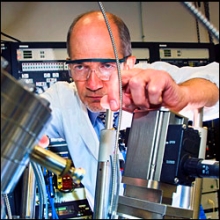May 2, 2011 — US Department of Energy (DOE) Brookhaven National Laboratory researchers are using precise atom-by-atom molecular beam epitaxy (MBE) layering to fabricate an ultrathin transistor-like field effect (FET) device to study the conditions that turn insulating materials into high-temperature superconductors. This advances our understanding of high-temperature superconductivity, and could also accelerate the development of resistance-free electronic devices.
 "Understanding exactly what happens when a normally insulating copper-oxide material transitions from the insulating to the superconducting state is one of the great mysteries of modern physics," said Brookhaven physicist Ivan Bozovic, lead author on the study and pictured here.
"Understanding exactly what happens when a normally insulating copper-oxide material transitions from the insulating to the superconducting state is one of the great mysteries of modern physics," said Brookhaven physicist Ivan Bozovic, lead author on the study and pictured here.
One way to explore the transition is to apply an external electric field to increase or decrease the level of doping (the concentration of mobile electrons in the material) and see how this affects the ability of the material to carry current. But to do this in copper-oxide (cuprate) superconductors, one needs extremely thin films of perfectly uniform composition and electric fields measuring more than 10 billion volts per meter.
Bozovic’s group used molecular beam epitaxy to uniquely create such perfect superconducting thin films one atomic layer at a time, with precise control of each layer’s thickness. They’ve shown that in such MBE-created films even a single cuprate layer can exhibit undiminished high-temperature superconductivity.
Now, they’ve applied the same technique to build ultrathin superconducting field effect devices that allow them to achieve the charge separation, and thus electric field strength, for these critical studies.
These devices are similar to field-effect transistors (FETs), in which a semiconducting material transports electrical current from the source electrode on one end of the device to a drain electrode on the other end. FETs are controlled by a third electrode, the gate electrode, positioned above the source-drain channel.
No known insulator could withstand the high fields required to induce superconductivity in the cuprates. This renders the standard FET scheme impossible for high-temperature superconductor FETs. Instead, the scientists used electrolytes, liquids that conduct electricity, to separate the charges. When an external voltage is applied, the electrolyte’s positively charged ions travel to the negative electrode and the negatively charged ions travel to the positive electrode. But when the ions reach the electrodes, they abruptly stop. The electrode walls carry an equal amount of opposite charge, and the electric field between these two oppositely charged layers can exceed the 10 billion volts per meter goal.
The result is a field effect device in which the critical temperature of a prototype high-temperature superconductor compound (lanthanum-strontium-copper-oxide) can be tuned by as much as 30 degrees Kelvin, which is about 80% of its maximal value — almost ten times more than the previous record.
The scientists have now used this enhanced device to study some of the basic physics of high-temperature superconductivity. As the density of mobile charge carriers is increased, their cuprate film transitions from insulating to superconducting behavior when the film sheet resistance reaches 6.45 kilo-ohm. This is exactly equal to the Planck quantum constant divided by twice the electron charge squared — h/(2e)2. Both the Planck constant and electron charge are atomic units.
"It is striking to see a signature of such clearly quantum-mechanical behavior in a macroscopic sample (up to millimeter scale) and at a relatively high temperature," Bozovic said.
The findings imply that electrons form pairs (although localized and immobile) in the insulating state, as well as the superconducting state, unlike in any other known material. That sets the scientists on a more focused search for what gets these immobilized pairs moving when the transition to superconductivity occurs.
Superconducting FETs might also have direct practical applications. Semiconductor-based FETs are power-hungry, particularly when packed very densely to increase their speed. In contrast, superconductors operate with no resistance or energy loss. Here, the atomically thin layer construction enhances the ability to control superconductivity using an external electric field.
The technical breakthrough is described in the April 28, 2011, issue of Nature (http://www.nature.com/nature/journal/v472/n7344/full/nature09998.html). Coauthors on the paper include: I. Bozovic, A. Bollinger, J. Yoon, and J. Misewich from Brookhaven Lab and G. Dubuis and D. Pavuna from Ecole Polytechnique Federale de Lausanne (Switzerland).
This research was funded by the DOE Office of Science and the Swiss National Science Foundation.
Follow Small Times on Twitter.com by clicking www.twitter.com/smalltimes. Or join our Facebook group

